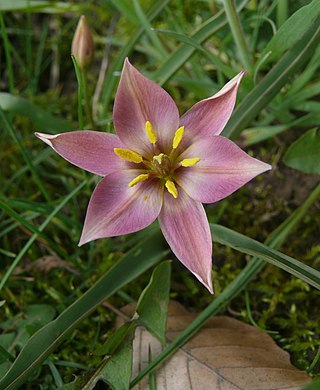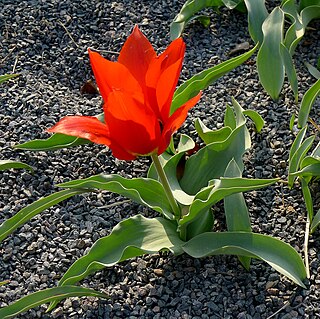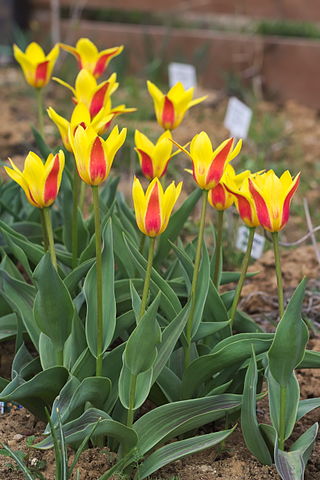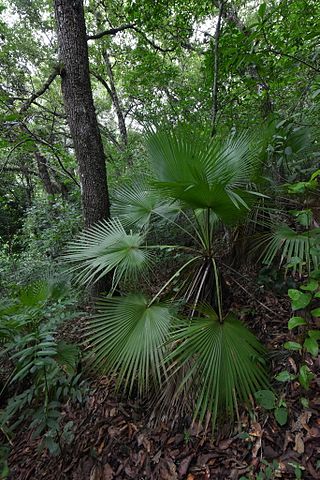
Hesperocyparis arizonica, the Arizona cypress, is a North American species of tree in the cypress family Cupressaceae, native to the southwestern United States and Mexico. Populations may be scattered rather than in large, dense stands.

Tulipa turkestanica, the Turkestan tulip, is a species of tulip native to Central Asia. It was first described by Eduard August von Regel in 1873 as a variety of T. sylvestris, then elevated to full species status two years later.

Ficus lyrata, commonly known as the fiddle-leaf fig, banjo fig, fiddle-leaved fig tree, lyre leaf fig tree, or lyre-leaved fig tree, is a species of plant in the mulberry and fig family Moraceae. It is native to western Africa, but is cultivated around the world as an ornamental plant. It has received the Royal Horticultural Society's Award of Garden Merit.

Tulips are spring-blooming perennial herbaceous bulbiferous geophytes in the Tulipa genus. Their flowers are usually large, showy, and brightly coloured, generally red, orange, pink, yellow, or white. They often have a different coloured blotch at the base of the tepals, internally. Because of a degree of variability within the populations and a long history of cultivation, classification has been complex and controversial. The tulip is a member of the lily family, Liliaceae, along with 14 other genera, where it is most closely related to Amana, Erythronium, and Gagea in the tribe Lilieae.

Tulipa albanica is a flowering plant in the tulip genus, family Liliaceae that is native to Albania. It was discovered near the village of Surroj in Albania in 2010. The plant is a critically endangered (CR) as it grows in an area smaller than 100 ha, surrounded by mining activities.

Tulipa humilis is a species of flowering plant in the lily family, found in Syria, Lebanon, Israel, Turkey, Iran, and the North Caucasus region of Russia. The flowers are pink with yellow centers. Its preferred habitat are rocky mountain slopes. It is known by several other names in horticulture.

Cytisus nigricans, the black broom, is a species of flowering plant in the subfamily Faboideae of the family Fabaceae. Growing 3–5 ft (0.91–1.52 m) tall, it is a slender deciduous shrub with erect branches. Masses of brilliant yellow, slightly fragrant pea-like flowers appear in long racemes on the current year's growth in summer and early autumn.

Tulipa cypria, the Cyprus tulip, is a tulip, an erect perennial bulbous herb, 15–40 cm high, with glabrous, glaucous leaves. It has four leaves which are alternate, simple, entire and fleshy. The two lower leaves are larger, lanceolate, 10-20 x 2–6 cm, with conspicuously undulate margins while the two higher leaves are much smaller, nearly linear. One terminal showy flower, perianth cup shaped, of six free, petaloid segments, 2.5-9 x 1-3.5 cm, with dark blood-red colour, internally with a black blotch bordered by a yellow zone. It flowers March–April. The fruit is a capsule.

Tulipa eichleri, commonly known as Eichler tulip or Eichler's tulip, is a species of tulip. It is a bulbous flowering perennial with long green leaves,deep red flowers with a central black blotch, coming from the Caucasus Mountains.

Tulipa hungarica, the Danube tulip, Banat tulip or Rhodope tulip, is a species of flowering plant in the family Liliaceae. It is also in the subgenus Tulipa. It is found on the rocky mountainsides of Bulgaria, Romania, Hungary and Slovenia, especially along the gorges of the river Danube. It has small bright yellow flowers in spring and blue-grey leaves.

Tulipa alberti, or Albert's tulip, is a species of flowering plant in the family Liliaceae. It has long reddish, orange or pink flowers. It comes from the mountains of Central Asia.

The taxonomy of Tulipa places the genus in the family Liliaceae, and subdivides it as four subgenera, and comprises about 75 species.

Tulipa montana is a species of tulip native to the mountains of Iran and Turkmenistan. With its deep red petals it has been proposed as a candidate for the Biblical Rose of Sharon, whose identity is unknown.

Tulipa biflora, the two-flowered tulip, is a species of tulip, native to the former Yugoslavia, Crimea, Anatolia, the Caucasus, southern Russia, Egypt, the Middle East, Central Asia, Iran, Pakistan, Afghanistan and Xinjiang in China. It has many synonyms, including Tulipa polychroma.

Tulipa fosteriana is a species of tulip, native to the Pamir Mountains and nearby areas of Afghanistan, Kyrgyzstan, Tajikistan and Uzbekistan.

Tulipa kaufmanniana, the water lily tulip, is a species of tulip native to Central Asia.

Tulipa greigii, is a species of tulip native to Central Asia and Iran.

Tulipa praestans is a species of tulip native to the mountains of Tajikistan. Many well known cultivars have been formed from the original plant.

Tulipa kolpakowskiana, or Kolpakowsky's tulip, is a species of tulip native to Afghanistan, Kazakhstan, Kyrgyzstan, and Xinjiang in China. Its petals display a floral iridescence which is perceived by bumblebees. It has gained the Royal Horticultural Society's Award of Garden Merit. Its ultimate height and spread ranges from 0.1 to 0.5 metres and 0 to 0.1 metres, respectively.

Brahea dulcis, the sweet hesper palm or apak palm, is a species of flowering plant in the family Arecaceae. It is native to dry woodlands of Mexico, Guatemala, Belize, El Salvador, and Honduras. A single-trunked palm reaching 7.5 m (25 ft) with edible fruit and green to blue-green leaves, it is occasionally available from commercial suppliers.



















